|
|
| TTR:
Trix Twin Railway |
| Trix
began as a German company
that manufactured metal construction kits (similar to Meccano). The holes in the metal
pieces were in rows of three, in an 'X' pattern. Hence Tri-X ... Trix! |
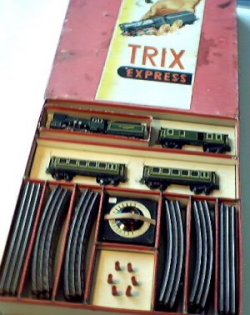 |
Trix electric trains
were first made in Germany in 1935 under the Trix Express label.
Trix trains made their debut in the U.K. at Christmas of that same year,
where they were sold and distributed by Bassett Lowke Ltd. as the 'Bassett-Lowke
Twin-Train Table Railway'. Bassett-Lowke were a well-established British
model making company, particularly of '0' gauge railways.
On the left is one of the first 1935 imported sets. It
includes a green 0-4-0 loco and tender with three coaches to represent Southern Railways colours.
The tenders were originally made with the words 'Twin Express' printed on the side, but
this was overpainted to become 'Trix Express'. |
| The first locos appeared
with solid wheels - later more realistic spoked wheels were introduced. The loco motors
ran on 14 volts alternating current, supplied by three-rail track. Trix had the
clever idea of enabling two locos to be independently controlled on one track, each
loco uses
one outer rail and the centre rail to draw current. Hence 'Trix Twin' - two trains on one
track. |
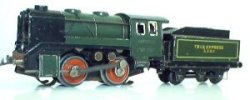 |
In 1937 new English-made body castings
were manufactured in the style of British rather than German steam locos. These locos,
along with British rolling stock, were on sale in LNER, LMS, and Southern liveries. In
addition to tender locos, tank locos were also produced in passenger and goods liveries
(below). |
The 1939-1945 war interrupted production, which
resumed in 1948. Some unsold pre-war items were sold post-war. The railway
companies LNER, LMS, GWR, and Southern were nationalised in 1948 to become British
Railways. By 1950 locos and rolling stock were in British Railways
livery: red and cream coaches, and green, blue, or black locos.
|
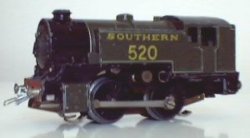 |
 |
 |
| Two American locos were
available using the 4-wheel AC mechanism, a passenger model with cowcatcher, and a freight
switcher. Primarily for export to the US and Australia, these locos were also sold in the
UK with American style rolling stock. |
 |
| Post-war, Trix locos continued to
operate on 14 volts alternating current, unlike rival manufacturers Hornby-Dublo and
Triang that used 12 volts DC. Trix locos had a complex reversing mechanism, which made
production expensive and operation less reliable. In Germany, Trix changed from AC motors to the
more efficient and reliable permanent magnet DC type. Unfortunately, the British Trix
company retained the old AC system for several years which contributed to their extremely
chequered history. They were taken over several times, with the models renamed Trix Twin
Railways, Trix Trains, British Trix and Liliput. |
 |
 |
| Two AC 4-4-0
locos were produced pre- and post-war in various liveries: the Midland
Compound (left, in LMS black), and the
NE Hunt Class 'Pytchley' (right, in LNER black). |
 |
| The British range of pre-war coaches
included 4-wheel suburban types, in LNER and LMS colours, and also bogie coaches. Pre-war
rolling stock couplings are of the hook and wire type, post-war is a tinplate hook designed by the
Peco company and very similar to that used by Hornby Dublo. |
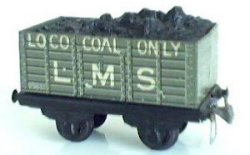 |
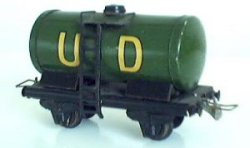 |
| Wagons available included tankers,
covered vans, timber trucks, coal, and bogie types. |
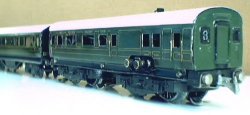 |
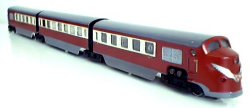 |
| Above is the pre-war Southern
Railways Electric multiple unit that used the motor chassis from the Diesel Flyer two-car
unit made by the Trix factory in Germany (below). A later version was the streamlined
Meteor Diesel Express (above right), made in both AC and DC versions. |
 |
| Trix produced a range of stations,
signal boxes, platforms, and other lineside accessories, in wood and metal. Illustrated
below is the gantry signal box, and the remote control signal. A solenoid in the signal
base operates a wire, concealed in the post, which moves the signal arm. A bulb
illuminates the miniature yellow and green spectacle discs. |
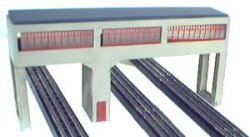 |
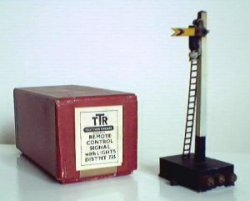 |
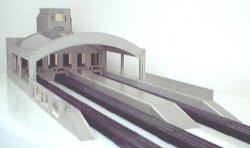 |
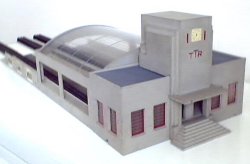 |
Above is the Manyways Terminal Station, comprising covered span, main
building, clock tower, entrance steps, buffers, and platforms. |
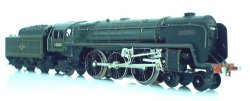 |
In 1956, Trix changed to 12 volt DC operation,
but the models were still three-rail and more expensive than other popular 00 brands. In
the late 1950's, Trix introduced a fine new range of realistic locos including Britannia
(left),
Class V, and EM1 Bo-Bo electric. |
By the
mid-sixties, Trix were manufacturing many items in plastic, rather than the earlier
diecast or tinplate. In 1967 the 3-rail system was replaced by the more realistic 2 rail
track - although the 3-rail range of items remained available to special order until 1972.
Later items bore the Liliput brand, then production
ceased in the seventies. However the spirit of Trix could still be found in Dapol and
Bachmann models in 1994/5 that used ex-British Trix/Liliput moulds and tooling. In 2003
the TTRCA acquired some of these moulds when Dapol ceased production.
Detailed information can be found in the definitive
reference book "The History of Trix HO/OO Model Railways in Britain" by Tony
Matthewman (New Cavendish Books, ISBN 0 904568 76 8, now out of print). In addition,
"The Bassett-Lowke Story" by Roland Fuller (also published by New Cavendish
Books) contains interesting information regarding the early years. |
Photos from TTRCA member Garry Lefevre |

Trix Bassett-Lowke wagon from 1938

German made electric loco 1939

London Transport
electric loco 1939

Shell tanker

NE Tarpaulin

Box lid illustration from
set produced for sale in France

TTR 0-4-0 tender loco 1955

Plastic body loco from 1956

Passenger Figures

Ruston Shunter
|

